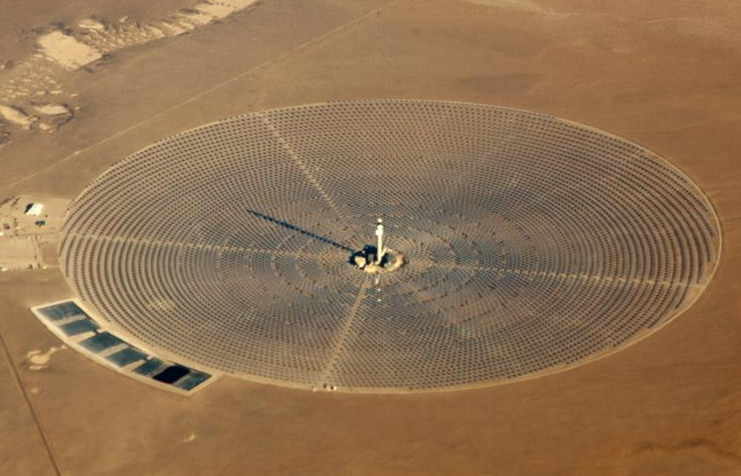A guest post by Alina Gilmanova, who with her colleague there; Zhang Haobin, provides a unique perspective from her work inside China and

Recently some media, such as Energyskeptic, falsely accused CSP technology of being unreliable, full of glitches and having a low energy return. Their opinion refers to certain early development faults of the technology, mainly based on the US experience, where new CSP stations have not been built since 2015.
Indeed, all power production technologies have their drawbacks, and we must have the full picture when considering different options. In the upcoming energy transition to zero emissions, dispatchable renewables are critical to ensure electricity security, and requires the massive deployment of all available clean energy technologies. Thus, it is unwise to discard a renewable energy technology, which could provide 24/7 power supply, especially in view of climate change urgency, only based on past problems in single stations.
Currently there are two main reasons for the performance (and therefore Capacity Factor) decreases in CSP tower plants (for more detailed reasons please check the CSP Best Practices Study – NREL):
1. The leakage of molten salt tank. Molten salt tank leaks have occurred in three solar tower CSP projects, such as Crescent Dunes (USA), Gemasolar (Spain), and NOOR3 (Morocco). Until the leak was stopped, generation had to stop too.
2. The steam turbine problems, which were especially noticeable among the Chinese CSP projects, but mainly due to the lack of experience in developing such a turbine.
The above issues are mostly related to engineering and chemistry: it is far from trivial to handle molten salt at very high temperatures, and it puts great strain on materials and systems. As demonstrated by the good track record of almost all salt tower stations, these difficulties are manageable. China has a rich experience in design and construction of molten salt tanks due to its previous experience in chemical engineering. Cosin Solar had its first 10 MW power plant with molten salt storage connected to the grid already in 2016, adding later two more 50 MW each power plants and none of them had leakage. In fact, no solar tower project in China has had a problem with molten salt leakage.
To better communicate the up to date data and decrease the misinformation about CSP, Cosin Solar – the technology provider and operator of the three commercial solar tower plants with experience of more than ten years of plant operation, – will provide its own recent data to counter misgivings about some drawbacks of CSP plant commonly cited by the media.
Starting with the capacity factor (CF) of a CSP plant, which is often criticized for being lower than projected by the builders and in the scientific literature, the following operational data from Qinghai Supcon Delogha 50MW CSP station is discussed.
This station is one of the first China national CSP demonstration projects located in Delingha City, Qinghai Province. The main data of the project are following:

[Ed: The author alerted SolarPACES that there was a mistake in this table. The actual GWh of annual generation is 146 GWh, not 1.46 GWh ! (as you can imagine…)]
This project was connected to the grid on December 30, 2018. After the commissioning period, it entered the assessment period on July 26, 2019. From July 26, 2019 to July 25, 2020, the power station completed its first full annual normal operation cycle. During this period, the cumulative DNI was 2013 kWh/m2 (slightly worse than the typical weather year DNI 2043 kWh/m2). According to the performance model, the expected generation should be 1374.8 GWh, while the actual power generation was 1218 GWh, with the achievement rate of 88.6% during the testing phase. This number is expected to increase with normal operation and with gaining experience with the power plant operation. There were also non-technical reasons slightly impacting the overall power generation, such as power grid maintenance, test daily 11 am -3 pm to reduce the load operation mode, etc. Figure 1 shows expected and real power generation of the plant by month.

As shown in the Figure 2 from February 1 to February 13, 2020, we verified the operation mode of full load during the day, load reduction at night, and continuous 24h non-stop operation, achieving three records simultaneously:
•293 hours of continuous, uninterrupted operation,
•the cumulative power generation of continuous operation was 8.39 GWh,
•and the average achieved rate of power generation during continuous operation was 105.2%, which fully demonstrates the advantages of CSP in providing a continuous and stable power output also during the night.

Finally, let’s not forget that the technology evolves with time and, especially CSP technology improves with more power plants being constructed. We should not be misguided about the performance of the technology only because of some problems that happened in a power plant seven years ago, when there was almost no experience with the solar tower design and operation.
Women in CSP group attracts over 100 initial members, starts website














































